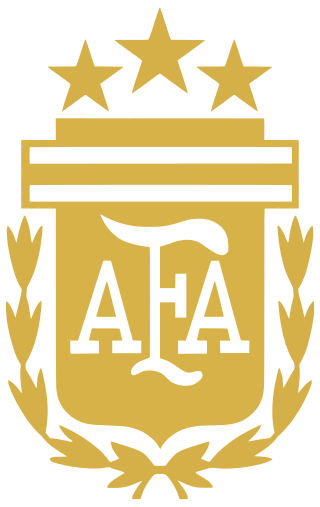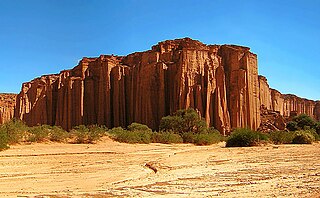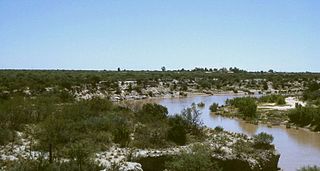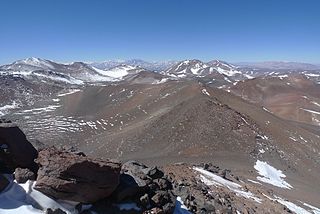Vinchina Departamento Vinchina | |
|---|---|
| Country | Argentina |
| Seat | Villa San José de Vinchina |

Vinchina is a department of the province of La Rioja (Argentina). [1] [2]
Vinchina Departamento Vinchina | |
|---|---|
| Country | Argentina |
| Seat | Villa San José de Vinchina |

Vinchina is a department of the province of La Rioja (Argentina). [1] [2]

The Río de la Plata, also called the River Plate or La Plata River in English, is the estuary formed by the confluence of the Uruguay River and the Paraná River at Punta Gorda. It empties into the Atlantic Ocean and forms a funnel-shaped indentation on the southeastern coastline of South America. Depending on the geographer, the Río de la Plata may be considered a river, an estuary, a gulf, or a marginal sea. If considered a river, it is the widest in the world, with a maximum width of 220 kilometres (140 mi).

Argentina is divided into twenty-three federated states called provinces and one called the autonomous city of Buenos Aires, which is the federal capital of the republic as decided by the Argentine Congress. The provinces and the capital have their own constitutions and exist under a federal system.

Buenos Aires, officially the Autonomous City of Buenos Aires, is the capital and primate city of Argentina. The city is located on the western shore of the Río de la Plata, on South America's southeastern coast. "Buenos aires" is Spanish for "fair winds" or "good airs". Buenos Aires is classified as an Alpha global city, according to the Globalization and World Cities Research Network (GaWC) 2020 ranking.

The Argentina national football team, nicknamed La Albiceleste, represents Argentina in men's international football and is administered by the Argentine Football Association, the governing body for football in Argentina.

The Argentine Navy is the navy of Argentina. It is one of the three branches of the Armed Forces of the Argentine Republic, together with the Army and the Air Force.

Alberto Ángel Fernández is an Argentine politician, lawyer, and academic who served as President of Argentina from 2019 to 2023. He was also the Chief of the Cabinet of Ministers from 2003 to 2008. His tenure as Cabinet Chief remains the longest since the post was created in 1994.

La Rioja, officially Province of La Rioja is a province of Argentina located in the west of the country. The landscape of the province consist of a series of arid to semi-arid mountain ranges and agricultural valleys in between. It is in one of these valleys that the capital of the province, the city of la La Rioja, lies. Neighboring provinces are, from the north clockwise, Catamarca, Córdoba, San Luis and San Juan. The dinosaur Riojasaurus is named after the province.

The Argentine Football Association is the governing body of football in Argentina based in Buenos Aires. It organises the main divisions of Argentine league system, including domestic cups: Copa Argentina, Supercopa Argentina, Copa de la Liga Profesional, Trofeo de Campeones de la Liga Profesional and the Supercopa Internacional. The body also manages all the Argentina national teams, including the Senior, U-20, U-17, U-15, Olympic and women's squads. Secondly, it also organizes the women's, children, youth, futsal, and other local leagues.

Club Atlético River Plate, commonly known as River Plate, is an Argentine professional sports club based in the Belgrano neighborhood of Buenos Aires. Founded in 1901, the club is named after the English name for the city's estuary, Río de la Plata. River's home stadium, Estadio Monumental, is the largest in South America.

The Primera División, known officially as Liga Profesional de Fútbol, or Torneo Sur Finanzas for sponsorship reasons, is a professional football league in Argentina, organised by the Argentine Football Association (AFA).

Cuyo is the wine-producing, mountainous region of central-west Argentina. Historically it comprised the provinces of San Juan, San Luis and Mendoza. The modern New Cuyo includes both Cuyo proper and the province of La Rioja. New Cuyo is a political and economic macroregion, but culturally La Rioja is part of the North-West rather than of Cuyo.
The Argentina men's national basketball team represents Argentina in men's international basketball officially nicknamed The Argentine Soul, and it is controlled by the Argentine Basketball Federation.

The Desaguadero River is a river in Argentina. Originating near the Tipas volcano in La Rioja at about 5,500 m (18,000 ft) elevation, the river is known in its upper reaches as the Bermejo or Vinchina. In its lower reaches, it is also known as the Salado. It joins the Colorado River in La Pampa Province near Pichi Mahuida. The Desaguadero has a total length of 1,498 km (931 mi) and its drainage basin is about 260,000 km2 (100,000 sq mi).

Argentina, officially the Argentine Republic, is a country in the southern half of South America. Argentina covers an area of 2,780,400 km2 (1,073,500 sq mi), making it the second-largest country in South America after Brazil, the fourth-largest country in the Americas, and the eighth-largest country in the world. It shares the bulk of the Southern Cone with Chile to the west, and is also bordered by Bolivia and Paraguay to the north, Brazil to the northeast, Uruguay and the South Atlantic Ocean to the east, and the Drake Passage to the south. Argentina is a federal state subdivided into twenty-three provinces, and one autonomous city, which is the federal capital and largest city of the nation, Buenos Aires. The provinces and the capital have their own constitutions, but exist under a federal system. Argentina claims sovereignty over the Falkland Islands, South Georgia and the South Sandwich Islands, the Southern Patagonian Ice Field, and a part of Antarctica.
Villa Unión is a city in northwestern Argentina and the main settlement of Coronel Felipe Varela Department with a population of 12,263.

Villa San José de Vinchina is a municipality and village in La Rioja Province in northwestern Argentina. It is the principal village of the Vinchina Department.

Famatina is an Argentinian Department in La Rioja Province.

Parofes is a mountain in Argentina. It has a height of 5,823 metres (19,104 ft). It's located at La Rioja Province, Vinchina department, at the Puna de Atacama. Its name is from the Brazilian mountaineer Paulo Roberto Felipe Schmidt, who died in 2015 due to leukemia. Until 2015 this peak was unclimbed and unnamed. However the mountaineers Maximo Kausch and Pedro Hauck, climbed and named it in 2015.
Reclus is a mountain subgroup or massif, in Argentina. It has a height of 6,300 metres (20,669 ft). It is located at La Rioja Province, Vinchina department, at the Puna de Atacama. Reclus is completely within Argentine territory. This peak was named after the French geographer Jacques Élisée Reclus.
Cerro Peñas Azules is a peak in Argentina with an elevation of 5,970 metres (19,587 ft) metres. Peñas Azules is within the following mountain ranges: Argentine Andes and Puna de Atacama. It is located within the territory of the Argentinean province of La Rioja. Its slopes are within the administrative boundaries of the Argentinean city of Vinchina.